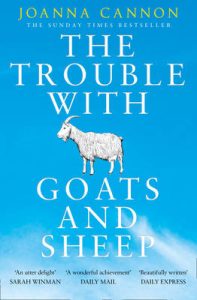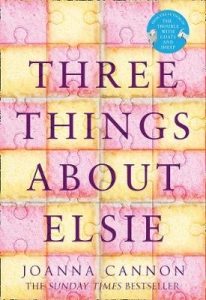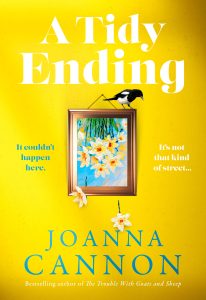Behind the Net Curtains, Mysteries and Meaning in Suburbia
Written for UEA Live by Sabina Dosani
On Wednesday 27th April, Joanna Cannon will be at UEA Live to talk about her new novel A Tidy Ending. In this new work, Cannon introduces Linda, who works part-time in a charity shop and lives an unfulfilled life in suburbia with her husband, Terry. Against the backdrop of their apparently uneventful lives, young women start to go missing. Many are already under Cannon’s spell, enchanted by her dazzling voice, and looking forward to the latest novel from a writer who is generous with her storytelling and with her wisdom. If you have not yet had the good fortune of meeting any of Cannon’s characters, let me tell you that in her novels you will come across characters who will live in your head for months, unsettling you and making you think differently about what really matters. You’ll also meet characters so kind and loveable, you will want to invite them over for tea.
 Deliciously funny and often devastating, Cannon is skilled at page-turning plots about disappearances and at telling heartbreaking stories that are packed with comedic moments. Her bestselling debut novel, The Trouble with Goats and Sheep opens with the line, “Mrs Creasy Disappeared on a Monday.” The story is narrated by a ten-year old girl, Grace, who decides to investigate the disappearance with her friend. This mystery and their quest frames life-affirming stories, told with humour and wonderfully imagined metaphors. Grace’s neighbourhood is brought together by an unexpected vision of Christ: “By lunchtime, Drainpipe Jesus had caused quite a commotion.” After several days of the community keeping vigil and bickering, Jesus is revealed as a creosote stain, but the neighbourhood’s behaviour during his apparent appearance sorted the biblical goats from the sheep. Rumours about child abduction, paedophilia and fatal arson are passed like contraband in Canon’s seventies suburbia. The most compelling mystery in Goats and Sheep isn’t what happened to Mrs Creasy, but which kind faces mask brutality, callousness, and cruelty. It is these questions about the essence of human behaviour that made this debut an immediate critical and commercial success.
Deliciously funny and often devastating, Cannon is skilled at page-turning plots about disappearances and at telling heartbreaking stories that are packed with comedic moments. Her bestselling debut novel, The Trouble with Goats and Sheep opens with the line, “Mrs Creasy Disappeared on a Monday.” The story is narrated by a ten-year old girl, Grace, who decides to investigate the disappearance with her friend. This mystery and their quest frames life-affirming stories, told with humour and wonderfully imagined metaphors. Grace’s neighbourhood is brought together by an unexpected vision of Christ: “By lunchtime, Drainpipe Jesus had caused quite a commotion.” After several days of the community keeping vigil and bickering, Jesus is revealed as a creosote stain, but the neighbourhood’s behaviour during his apparent appearance sorted the biblical goats from the sheep. Rumours about child abduction, paedophilia and fatal arson are passed like contraband in Canon’s seventies suburbia. The most compelling mystery in Goats and Sheep isn’t what happened to Mrs Creasy, but which kind faces mask brutality, callousness, and cruelty. It is these questions about the essence of human behaviour that made this debut an immediate critical and commercial success.
Both The Trouble with Goats and Sheep, and Cannon’s second novel, Three Things about Elsie, are packed with a sense of community and integrity that evoke nostalgia for older, simpler ways of life. And yet, even as her readers are hearkening back, Cannon dismantles the simplistic notion that the past is a safer, kinder place, by weaving narrative strands of wisdom and morality with absurd observations. In Three Things about Elsie, Cannon leads us back and forth through the life of eighty-four-year-old Florence. Elsie is Florence’s best friend. When readers first meet Florence, she has fallen in her flat in her sheltered accommodation and is waiting for help. Through flashbacks, reminiscences and other temporal disruptions, things don’t quite add up. These compelling micro-mysteries made me re-examine many things I had taken for granted. My father-in-law, my children’s grandfather, lives in an institution similar to Cherry Tree Home, where Florence lives. Three Things About Elsie made me newly curious about his life and re-examine societal ageism.
about Elsie, are packed with a sense of community and integrity that evoke nostalgia for older, simpler ways of life. And yet, even as her readers are hearkening back, Cannon dismantles the simplistic notion that the past is a safer, kinder place, by weaving narrative strands of wisdom and morality with absurd observations. In Three Things about Elsie, Cannon leads us back and forth through the life of eighty-four-year-old Florence. Elsie is Florence’s best friend. When readers first meet Florence, she has fallen in her flat in her sheltered accommodation and is waiting for help. Through flashbacks, reminiscences and other temporal disruptions, things don’t quite add up. These compelling micro-mysteries made me re-examine many things I had taken for granted. My father-in-law, my children’s grandfather, lives in an institution similar to Cherry Tree Home, where Florence lives. Three Things About Elsie made me newly curious about his life and re-examine societal ageism.
Florence is a not-quite reliable narrator, reminiscent of Emma Healey’s Elizabeth is Missing or Gail Honeyman’s Eleanor Oliphant is Completely Fine. Through temporal collisions, when Florence’s past crashes into the present, her memory loss and other aspects of dementia become plain. It is impressive to find an unreliable narrator handled with such authorial care and respect. The same authorial gentleness is used in Goats and Sheep, when readers are shown the lack of agency in an adult-world filtered through the ten-year-old narrator Grace’s eyes: “My mother said I was at an awkward age. I didn’t feel especially awkward, so I presumed she meant it was awkward for them.”
Throughout Three Things about Elsie, the quotidian medical details are impressive: “When we get to hospital, I will be taken across A&E and through red double doors, to people with the same questions and the same bright lights, and they will wheel me down blank corridors and put me through their machinery.” Elsie’s imagined ride in the ambulance, her arrival the emergency department and feeling soothed by the “quiet hands” of the nurse have a biographical quality.
When Cannon writes, in Three Things about Elsie, “You can see the fracture lines in people sometimes, if you search hard enough. You can see where they’ve broken and tried to mend themselves,” I wondered if she might be writing about her own fracture lines.
 Cannon read medicine at Leicester University in her thirties and worked as a hospital doctor before specialising in psychiatry. She has said in several newspaper interviews that she wrote The Trouble with Goats and Sheep in half-hour lunch breaks, and that her writing began as a form of therapy, to help her make sense of all she saw and felt as a junior doctor. She has written more about the quiet efficiency and competence of emergency care in Breaking and Mending, Cannon’s memoir about her life as a junior doctor presented as a series of short snapshots. She uses these small time-bounded dramas to interrogate big themes like the value of human kindness, life-changing interpersonal connections, the pernicious bullying in medical hierarchies and the brutalities baked into systems of healthcare. Her memoir is much more than a well-told series of vivid sketches of life as a junior doctor. Cannon dissects the construction of professional boundaries and choreographs the dance of closeness and emotional distance. In Breaking and Mending, she comments that people applying to medical school all say that they like people, “but what we’re really saying is that we like stories. Stories bind us together, stories unite us, and we tell our stories in the hope that someone out there will listen, and we will be understood.” This meditation on the power of words reminds me of one of Grace’s lines, in The Trouble with Goats and Sheep: “I still hadn’t learned the power of words. How, once they have left your mouth, they have a breath and a life of their own. I had yet to realize that you no longer own them. I hadn’t learned that, once you have let them go, the words can then, in fact, become the owners of you.”
Cannon read medicine at Leicester University in her thirties and worked as a hospital doctor before specialising in psychiatry. She has said in several newspaper interviews that she wrote The Trouble with Goats and Sheep in half-hour lunch breaks, and that her writing began as a form of therapy, to help her make sense of all she saw and felt as a junior doctor. She has written more about the quiet efficiency and competence of emergency care in Breaking and Mending, Cannon’s memoir about her life as a junior doctor presented as a series of short snapshots. She uses these small time-bounded dramas to interrogate big themes like the value of human kindness, life-changing interpersonal connections, the pernicious bullying in medical hierarchies and the brutalities baked into systems of healthcare. Her memoir is much more than a well-told series of vivid sketches of life as a junior doctor. Cannon dissects the construction of professional boundaries and choreographs the dance of closeness and emotional distance. In Breaking and Mending, she comments that people applying to medical school all say that they like people, “but what we’re really saying is that we like stories. Stories bind us together, stories unite us, and we tell our stories in the hope that someone out there will listen, and we will be understood.” This meditation on the power of words reminds me of one of Grace’s lines, in The Trouble with Goats and Sheep: “I still hadn’t learned the power of words. How, once they have left your mouth, they have a breath and a life of their own. I had yet to realize that you no longer own them. I hadn’t learned that, once you have let them go, the words can then, in fact, become the owners of you.”
Cannon has also written, “Patients will always remember how you treated them.” During my experiences as a patient, I have found that to be true. It is similar to the lingering memoires I’ve had as a reader. I also remember how an author treated me. Cannon is a safe pair of authorial hands, but she is more than that. She leaves her readers feeling hopeful, full of faith in the powers of kindness, respect, and generosity. I’m looking forward to A Tidy Ending.
Sabina Dosani is in the third year of a PhD in Creative and Critical Writing at UEA. She read medicine in London and has been working as a psychiatrist for over 20 years. Sabina was recently named as a BBC/ AHRC New Generation Thinker. She lives in the countryside with her family, dog and hens.

